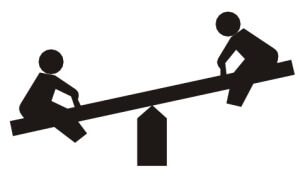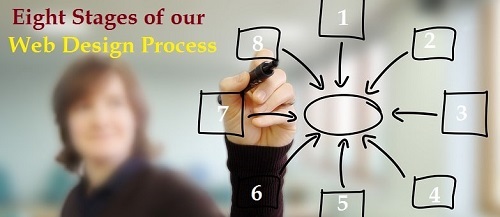Typography Trends in Web Design: From Serif to Sans Serif and Beyond
Explore the evolution of typography in web design, from classic serif and sans-serif fonts to modern trends.
In the ever-evolving realm of web design, typography serves as a powerful tool for conveying messages, establishing brand identity, and enhancing user experience. From the classic elegance of serif fonts to the modern simplicity of sans-serif, the journey through typography trends is a fascinating exploration of style, substance, and user interaction.
As one of the best website designing company in India, we understand typography’s pivotal role in crafting compelling digital narratives.
Join us on a journey through the evolution of fonts, exploring how they impact readability, accessibility, and overall design aesthetics.
Evolution of Typography in the Digital Age
The transition from print to digital media has brought about a revolution in typography. While print design allowed for precise control over every aspect of typography, the digital landscape introduced new challenges and freedoms. At ICO, we’ve witnessed this evolution firsthand, adapting our approach to typography to suit the dynamic nature of the online environment.
“Digital typography demands more than just visual appeal; it requires adaptability, scalability, and responsiveness.”
Fonts need to render flawlessly across various devices and screen resolutions. This shift has propelled designers and developers to explore web-safe fonts, Google Fonts, and custom font-loading techniques to ensure optimal performance without compromising design aesthetics.
The Psychological Impact of Fonts
Beyond aesthetics, fonts have a profound psychological impact on users. Each font carries its associations and evokes specific emotions.
 For instance, a playful and casual font might be suitable for a children’s website or a creative agency aiming to convey a friendly and approachable vibe. Meanwhile, a clean and professional font choice would be more fitting for corporate or financial institutions seeking to convey trust and reliability.
For instance, a playful and casual font might be suitable for a children’s website or a creative agency aiming to convey a friendly and approachable vibe. Meanwhile, a clean and professional font choice would be more fitting for corporate or financial institutions seeking to convey trust and reliability.
Understanding the psychology behind font choices allows designers to align their selections with the intended emotional response. As a website development company in Delhi, we recognize the importance of using fonts that resonate with the target audience, fostering a deeper connection and eliciting the desired user response.
Accessibility and Inclusivity Through Typography
In the pursuit of user-centric design, accessibility plays a pivotal role. Web designers must ensure that their chosen fonts cater to diverse user needs, including those with visual impairments.
“Fonts with excellent legibility and readability, appropriate font sizes, ample spacing, and sufficient color contrast contribute to a more inclusive web experience.”
This inclusivity extends to localization and internationalization efforts. Websites targeting global audiences must consider fonts that support various languages and characters, allowing for seamless communication across cultures. As a website development company in India, we emphasize the importance of inclusive design practices that prioritize accessibility without compromising on aesthetics.
Typography as a Storyteller
Typography isn’t merely a visual element; it’s a storyteller that communicates the essence of content. The hierarchy established through font choices, sizes, and styles guides users through the narrative.
Headlines draw attention, subheadings organize information, and body text delivers the core message.
At ICO, we leverage typography to enhance storytelling on websites. Strategic use of typography aids in creating engaging content structures that keep users immersed and encourage exploration.
“It’s not just about what is said but also about how it is presented through the artful use of fonts.”
The Future of Typography in Web Design
The landscape of typography in web design continues to evolve, presenting exciting opportunities for innovation. Variable fonts, for instance, offer a single file that contains multiple variations of a typeface, allowing for greater flexibility and creativity in design while keeping file sizes minimal.
Moreover, with the rise of immersive technologies like augmented reality (AR) and virtual reality (VR), typography is expected to extend beyond the confines of screens, integrating seamlessly into interactive and three-dimensional spaces.
As a forward-thinking eCommerce website development agency in India, we eagerly anticipate how typography will evolve to complement these emerging technologies.
The Fonts
The Classic Elegance of Serif Fonts
Bold serif fonts have long been associated with tradition, authority, and a touch of sophistication. Historically rooted, they exude a timeless charm that resonates with certain brands seeking to establish a sense of trust and reliability. In the context of web design, serif fonts can evoke a sense of formalism and elegance, making them suitable for websites related to art, literature, or institutions.
The Modern Simplicity of Sans-Serif Fonts
On the flip side, the rise of the digital era has brought about a surge in the use of sans-serif fonts. These fonts, characterized by clean lines and a lack of decorative strokes, offer a contemporary and minimalistic appeal.
We recognize the prevalence of sans-serif fonts in creating a modern, user-friendly online presence. They are often favored for their readability on various devices and screens.
 Breaking Boundaries with Experimental Fonts
Breaking Boundaries with Experimental Fonts
In the quest for uniqueness, designers are increasingly experimenting with unconventional and custom fonts. These experimental fonts, often bespoke creations, add a touch of creativity and originality to a brand’s visual identity.
At ICO, we encourage our clients to consider the bold statement that experimental fonts can make, provided they align with the brand’s personality and message.
Impact of Font Choices on Readability and Accessibility
While style is undoubtedly crucial, the practical aspects of readability and accessibility cannot be ignored. In the era of mobile browsing, responsive design, and diverse user needs, choosing the right font is paramount, for websites targeting a global audience, incorporating fonts that support multiple languages is essential.
As SEO experts in Delhi, we emphasize the importance of making content accessible to a broad audience for enhanced search engine visibility.
Selecting Fonts Aligned with Design Objectives
We recognize that font selection should align seamlessly with design objectives.
For a corporate website, combining sans-serif fonts for clarity and a serif font for headers can strike a balance between professionalism and approachability.
E-commerce sites may benefit from bold, easily readable fonts to highlight product details, while artistic portfolios can explore more unique and expressive typefaces.
Typography as a Brand Identity Builder
 In the realm of branding, typography plays a pivotal role in establishing and reinforcing a brand’s identity. At ICO, we often collaborate with clients to identify fonts that not only resonate with their target audience but also align with the personality and values of their brand.
In the realm of branding, typography plays a pivotal role in establishing and reinforcing a brand’s identity. At ICO, we often collaborate with clients to identify fonts that not only resonate with their target audience but also align with the personality and values of their brand.
“Consistency in font usage across various platforms helps in creating a cohesive and memorable brand image.”
Bold typography can be particularly effective in conveying a brand’s strength and confidence. It draws attention and can serve as a powerful visual anchor on a website. This is especially relevant for businesses seeking to make a bold statement in the competitive online landscape.
As the best website designing company in Delhi, we’ve witnessed the impact that strategically chosen bold fonts can have on brand recall and user engagement.
Dynamic Typography in Responsive Design
The advent of responsive design has brought forth new challenges and opportunities in the world of typography. As users access websites on a myriad of devices, from large desktop monitors to small smartphone screens, the importance of web development in India and elsewhere in creating adaptable and dynamic typography has become paramount.
Responsive typography involves the use of fluid grids and media queries to ensure that text adjusts seamlessly to different screen sizes. This not only enhances user experience but also contributes to the overall aesthetics of the website.
At ICO WebTech, we emphasize the need for responsive typography in our projects to ensure a consistent and enjoyable experience for users across diverse devices.
Navigating Font Pairing for Visual Harmony
Beyond the choice between serif and sans-serif, the art of font pairing adds another layer to typographic design. Combining fonts thoughtfully can create visual interest, hierarchy, and a harmonious overall look. As a website designing company in Delhi, we often experiment with font pairings to strike the right balance between heading and body text, ensuring readability and aesthetic appeal.
Recommendations for Effective Font Pairing:
- Pairing a bold sans-serif font with a delicate serif font for a modern and sophisticated look.
- Using a consistent font family but varying weights and styles to create a visual hierarchy.
- Experimenting with contrasting fonts to highlight key elements on a webpage.
Typography and User Engagement
The impact of font choices extends beyond aesthetics and readability—it directly influences user engagement. Consider a scenario where a user lands on a website, and the typography is difficult to read or feels mismatched with the content. This can lead to a negative first impression and potentially drive users away.
As a website designing company in India dedicated to creating engaging digital experiences, we emphasize the need for user-centric typography. Fonts should be chosen not just for their visual appeal but also for how they contribute to a positive and immersive user experience.
The Role of SEO in Font Selection
In the competitive digital landscape, visibility on search engines is crucial. Here’s where the role of SEO experts in India becomes intertwined with typography.
Search engines consider various factors, including page load speed and mobile-friendliness, in their ranking algorithms. Choosing web-friendly fonts that don’t compromise performance is a key consideration.
Additionally, the use of proper HTML tags for headings and subheadings with strategic placement of keywords in the text contributes to better search engine optimization.
At ICO WebTech, we collaborate with designers to strike a balance between visually appealing typography and SEO-friendly practices.
Conclusion
Typography stands at the intersection of aesthetics, functionality, and user experience in web design.
As a dynamic and ever-evolving discipline, it influences how content is perceived, understood, and engaged with by users. Embracing the power of typography allows designers to craft meaningful and memorable digital experiences that resonate with audiences on a profound level.
As a leading web design agency in Delhi committed to pushing the boundaries of design, we advocate for a holistic approach to typography—one that considers not only visual appeal but also accessibility, storytelling, and the evolving trends shaping the future of web design.
“Typography isn’t just about letters and characters; it’s about creating a captivating visual language that speaks volumes to users worldwide.”
Its time that small businesses should start focus on personalization
As a leading website design company in Delhi we always focus on creating websites for humans and make a friendly experience for the website visitors. The most effective strategy of our web designing company is that we think from customer’s perspective.
It is never easy to put personalization into practice when it comes to web designing and in 2019 it is even more difficult. In 2019 every business should work as a unit towards personalization. It is not the sole job of the marketing team and business owners. Web designers should be equally involved in personalization as a digital marketing strategy.
Here are 5 ways through which website designing companies in Delhi or anywhere can hold their grip on creating personalized experience for website visitors in 2019.
1) Personalized suggestions to website visitors
You can make your website design more engaging by providing better recommendations or suggestions. For example using cookies can give you information about your customers preferences and you can use it to provide personalized recommendations on your website.
For ecommerce website designing you can always include design elements for recommendations of relevant products to online customers and keep them engaged.
For blog designing, if you are monetizing it, you can always use remarketing for serving most relevant ads when the visitor is on your website.
2) Intuitive Signing up process.
Business growth depends on the conversion rate and the website visitors can convert into customers with an over all smooth experience on the website. Out of all the first step is signing up process. If the signup process irritates your website visitors then all the efforts of digital marketers are wasted.
Here is how you can implement personalization in sign up process on your website. Present personalized content on every step on the sign up to keep visitor engaging.
For example in the very first step of sign up your customer gives his name. Why not use the name on every screen and create a personal environment.
This is one of the example. You can always use CTAs, Social Media and valuable propositions to make your sign up process more personalized.
3) Present user specific content.
Every customer is unique and so are the website visitors. Some want proof of your work, other wants to read your blog. Based on the online behavior of your website visitors you can present personalized content to them.
Example of personalized content on website are the travel websites like Make My trip and Trivago They present personalized content to every visitor based on their online behavior and characteristics.
This will add more personal touch to your website for every website visitor and give you more conversions online. This could only be achieved if digital marketing and SEO companies in Delhi include their web designers as a part of marketing team.
4) Take a step further for your high value customers.
Find ways to wow your high value customers. Keep them informed that you always care about them. A personal message sometimes on the after login screen is more than enough. But you need to find what your high value customers like.
It becomes comparatively easy for existing high value customers as you have their behavioral data based on their usage on your website. If you keep delighting them at regular intervals using your web designing skills they will never leave you.
You can always do A/B testing for personalizing user experience for your high value customer group. Websites like Optimizely is doing it very effectively for their users.
5) Don’t forget returning website visitors.
As a website design company you must have ideas to welcome and wow returning visitors on the website. For example you can reduce the signin process for your returning customers.
If you delight returning customers then there chances they will bring 4 more new customers along with them and it is good for any business.
Conclusion:
If you want to beat your competition in 2019 then you must focus on providing personalized experience to your website visitors. You can always take the help of a good website design company
Reach us now @ +91-8447380262 and learn how we can help you create a personalized experience on your website for every online visitor.
Eight stages Of Our Web Design Process
ICO WebTech Private Limited is a leading web design and development company in Delhi with a perfect web design process.
We provide Website designing along with SEO and other Internet Marketing services to businesses across Delhi and all parts of India and help them increase their rankings on Google and generate more sales. We also provide outsourcing services for Web design and Digital Marketing to clients across USA, Canada, UK, Australia, Italy and help them save almost half of the cost for their digital marketing and web design work.
Being one of the best website design companies in Delhi It is our responsibility to make sure we provide maximum ROI to our clients who trust us.
We have designed a robust Web design process which tracks all the investments of our clients along with the revenue they generate from their website.
Stages of our web design process from start to finish
- Defining the project
Our web design service starts with defining the project. This starts with initial consulting. We are based at Malviya nagar, New Delhi, India but we help businesses all across India and overseas to generate more revenue and increase sales funnel through their website.
We start with defining business goals and identifying the opportunities how a well optimized website can do wonders for the overall marketing strategy. This helps our web development team to build the website exactly as per the requirement of the business.
During our initial consultation with business owners we identify the website goals and target audiences keeping the interest of stake holders in mind. We define a way how the business will stand out of the competition with a strong online presence.
- Scope of the project
Project scope is the most important and critical step of our web design service. We define the deliverable, timelines and important activities to achieve the desired results in the project definition process.
The project scope is well documented and sent for approval to our clients. After which it is uploaded on our project management tool to be available for our project teams with tasks defined with timelines for every individual involved in the project.
- Website Architecture
We then move to designing the architecture for the website. This includes basic visuals for various pages and the wireframes and the sitemap for the content flow.
This stage of our web design process provides a detailed reflection of how the content will flow through various pages of the website with maximum user engagement. It gives an overview of how the website pages will look.
This helps us to define how the customer will browse through the website and ultimately gets converted into a potential sale.
- Designing
Once the sitemap and wireframes are ready for the website, the project is transferred to our website designers. Our team of expert website designers create the style of the website with various color effects of every section to get the most appealing look for the website.
This is also a very important stage as the complete brand image is visually defined on the website design. We also check in this phase that the website looks exactly what is defined in the project definition and is targeted to achieve the goals.
The visual designs are sent to the client for approval.
- Website Development
After getting the approval from our clients we start the fifth stage of website development. This stage converts the ideas into finished plan sets.
This stage includes converting the designs into fully functional web pages using HTML5, CSS3, PHP and MySQL. That’s what our technical expertise is. Content is populated and various call to actions and lead capturing techniques are implement in this stage of our web design process.
We make sure in this stage that the website is developed for maximum conversions with a delightful user experience. We also make sure that the website is working fine on all the browsers, and it is SEO friendly so that the search engines can easily crawl every page.
We build responsive websites so this functionality is also being worked during this stage. We make the website compatible with all the devices like smartphones, tablets, desktops and laptops of all sizes.
- Website Testing
In this stage the website is placed on our testing server to check the performance of the website in real online environment. In this stage of our web design process we check the website loading speed, cross browser functionality and responsive nature.
All the critical points are thoroughly checked and website is made fool proof. Apart from checking the technical aspects we also check the misspelled words, broken images and broken links as a single mistake anywhere in the website can cost the reputation of the business.
The test server link is sent for approval to the client.
- Website Launch
Once the website is approved then the most awaited day arrives. We launch the website. But our website design process is not over here. We provide FREE support for 2 months after we launch the website.
During these 2 months we monitor the website. We take and implement the users feedback and do not leave a stone unturned if there is any scope of improvement. We constantly work towards getting the website next to perfect when it comes to performance.
We also make minor changes as required by our clients free of cost during this free support of 2 months.
- Website Maintenance
As the internet is constantly changing we make sure that the website is up to date with the new emerging trends and technologies with our website maintenance. We make the content changes to attract more visitors. We make sure that the website is secured and also remove the malware if they pop up during the 8th stage of our web design process.
We take regular backups and provide analytical insights for our clients to review the real time performance of the website. We track the number of users on the website weekly and monthly and constantly work to decrease the bounce rate of the website.
We also do the design changes as required for the changed business strategies.
Contact our expert web designers and web developers to get your website designed.
Contact us for a FREE Consultation today
Why every small business should have a website?
Importance of a website for small business
Online market for every industry is booming. And almost every large and medium size business is making huge profits out of their websites. Simply because they understand the importance of a website and the benefits they can reap out of a good website.
Being one of the top website design company in Delhi NCR India we provide Website design and digital marketing services to businesses of all sizes.
We have realised that there is still a big room to create awareness among the small business about the importance of a website for their business.
Often our sales guys get excuses from many small business owners that they do not need a website. Because they think it is a waste of time and they believe in the traditional marketing .
Almost 80% of small business owners in Delhi NCR alone are not aware of the importance of a website for their business.
Our promotional campaigns are more intended towards creating awareness about internet and why is it important to have a website.
Below are the top 4 reasons citing the importance of a website for a business and its success.
#1. A good website increases your customer reach.
In this era of online world customers look for product and services online. Because they can do online shopping, reach out for service providers like plumbers, carpenters, etc from the comfort of their home and time.
More than 20 million customers are online every time either doing online shopping, looking for online help or services. These customers could be online even during midnight from anywhere.
Businesses which have a website and a good online presence have more chances of these potential customers contacting them from the websites, even when their shops or offices are closed.
Customers search for the services or products mostly on Google and they most often click on the websites which appear on first page of Google search result.
If you do not have a website with strong online presence then you are loosing these potential customers to your competitors who have a website and have 24 by 7 visibility online for their business.
A website acts as a 24 by 7 shop for your business.
Wonder how much sales and money you are loosing without a website.
#2. A good website increases the credibility of your business.
Customers these days judge the credibility of any business by their website.
A website makes your business look credible and professional.
People don’t even consider a business as an option if they do not have a website. A good website professionally explains your services and products. Thereby leaving a good first impression about your business.
Website is the face for any business.
If you can impress your potential customers with your website then half of the battle is won. Once you have a website with a strong online presence you will see how it helps grow your sales and how you can earn huge money from your website.
#3. Website is the most cost effective marketing method for your services and solutions.
Most of the small businesses make excuses and give cost as a reason for not getting a website for their business. They find traditional print advertising more tempting.
This is simply because they are not aware of the importance of a website for their business.
Compared to the traditional print media expenses, website can help you reach more customers and 24 hours in a day.
For example:
If you give a newspaper ad for your service or product, it is not guaranteed it may reach the customers you are looking for.Because a newspaper can be read by students, elderly people, house wife. Therefore it is not sure your advertisement reaches the customers you are targeting.
On the other hand if you have good website for your business which is a Search Engine Optimized website then your target customers who are looking for your type of services will reach you through your website.
Read more about Search Engine optimization here.
#4. Website works round the clock for you.
As mentioned above a good website never stops working for your and attracting customers 24 hours a day round the year.
A customer can fill a simple short contact form on your website and you will get an email with the questions or inquiry from your potential customers. And you never ever miss a single customer even when you are sleeping.
A website makes your business grow day and night.
A customer can reach your website from anywhere like from a coffee shop, while having a walk, while traveling or whatever you can think about.
And a website promises only potential targeted customers who actually are in need for your services or products.
Bottom Line: A website is very important for any size business
You just need to make sure that your website is done the right way.
Keeping the basics right will give you a good professional looking website with a strong online web presence.
There are many free services which can give you a website but you need to do the hard work yourself. It is always suggested that let the experts do the job for you and you concentrate on your core business.
To get the the website that works for your business hire the best website design company. You should choose the web design company who can also give you a strong web presence. And that too at a very affordable and cost effective way.
Learn more about how to choose the best website design company.
We will help you in a cost effective way to grow your business through your website.
Contact our small business website experts today and discuss your business requirements.
Hire a web designer not a Ninja
Never look for Ninja qualities while hiring a web designer

Like any normal businessman I had my own fears while starting up my organization that too a one which will cater to the offshore outsourcing business in IT sector. First and foremost I wanted a set of people who not only had expertise in their field but also sense of responsibility towards their work and followed work ethics to the core and trust me this was really daunting.
So to begin with I first stepped into my customers shoe to see what would i want from a firm and its employee if I had to outsource my business and that too to a organization which is based in some other part of the world. I penned down a few things to make things before I started hiring people.
Firstly I was looking for people who had all the knowledge about coding, designing and layouts of a website. But then again bookish knowledge is not all that I was looking for, I needed a person who also had experience in web development along with the knowledge.
But again with that kind of experience and knowledge I also wanted the person to be imaginative and creative at the same time. Because only if you are creative and can design something out of the box you can create a buzz in the market.
Now when you are working in a IT sector one always need to be updated with the ever growing technology and things around it.
You can not sit with one veggie and create a buffet for your guests
You need to have plenty of stuff to do so. One has to think ahead as there will be a day when you have to update, modify the website or the apps as per the requirement of the client and time.
One of the most important quality that was taken into account was the communication skills. If the communication skills of the web developer are not good it can be major draw back. The developer will face problems in both understanding the customer and their needs along with what he would like to convey to them.
OK I know this one may not stand true for all but in my case I would really want someone with high patience levels and also know the tricks to get rid of those hackers and their viruses. We all know it may take ages while testing program or detecting that one bug that can totally destroy you.
SEO is a crucial aspect in web development and hence the developer should be well aware of that ways and tools to build and design a website for the search engines too.
Along with all the above mentioned, the developer should also be ready to improve his skill sets. As in should know more languages to work on by which I don’t mean the ones we speak but the ones used to develop a website for example PHP, CSS, Java etc.
Last but not the least is the trust. You need to trust your developer with what he brings to the table using his skills. But this doesn’t mean that you can’t question, you definitely can but if you doubt them its better to avoid that job other wise you may land yourself in soup.
I know it will be stupid of me to get all the check-boxes ticked but at least I would look most of them in a web developer.
User Experience, a must for your website visitors
All of us have got are websites up and running to showcase our products and services to the audiences. We keep them all loaded with content, images, testimonials, blog and what not but, while designing the website most of us tend to forget a very important factor which attracts more customers. And that is designing a user friendly website.

So the next thing that comes in our mind is what can be done without compromising on our design.
I have pen down a few pointers that may help you.
- That irritating loading sign- one of the first thing we should get rid of as soon as possible.These days everybody wants quick solutions for everything be it food, shopping, downloading of stuff etc. The speed of the page by which I mean the time the page takes to load can be decreased by keeping your design simple. The more time it takes to load the page there are more chances that you loose that customer.
- Next comes the navigation path. Again the path should be such that the consumer doesn’t feel lost. All important pages that you need in your website should be on the menu itself so that it becomes visible and easy to access. For example for contact us you can have a small icon on the home screen too apart from it being a separate page by itself.
- Website Design – make sure that you don’t clutter the website with too many images, ads or content for that matter because then it becomes very difficult for the consumer to focus on one thing and gets distracted very easily. Make sure you have a descent ratio for same.
- Another important aspect in today’s scenario is to keep up with technology . The website design should be mobile friendly which means it should be compatible on mobile operating systems too like iOS, Android and windows. One should make sure it does not go flubby.
Website Design plays a vital role in the success of your business . User friendly websites helps to provide a seamless experience for visitors and improves your chances of success. It is one of the factors that sets a professionally designed website apart from the rest.
Contact ICO Web Solutions now to get a user friendly design of your website.
Things to keep in mind when building your brand on the World Wide Web
Brand is nothing but an image of a particular product or a company that it has in the market for itself. It’s basically a company’s face, consumers recognize the product and the service by its brand especially in today’s market scenario where the market has extended its arms to the world. Hence brand building becomes an important asset of any business and not only to survive in the market but also to gain the trust of the consumers.
Why is Offshore Outsourcing Management necessary?
Signing-in is the Beginning
If you think that after signing in the contract you are free and the Outsourcing process is complete; you are wrong my friend. It has just begun. Now you will truly start the business relationship and effective and meticulous Management oversight will be essential hereafter.
You must be thinking, I already have a management team to take care of Outsourcing projects, I don’t need to worry about it. But, here is the difference, it doesn’t matter if you are a big corporation or a small business, but if your plan is to regularly outsource work, you will need to frame a systematic structure to manage your outsourcing process. I have collaborated a few points which will help you manage your business for successful outsourcing.
Why do I need Outsourcing Management to improve my business?
Yes, absolutely! I need not mention the many benefits of Outsourcing, but undoubtedly the outsourcing process also requires good management to make it an accomplishment. It starts right from selecting a service provider, to negotiating the deal, managing the relationship and dealing with the distributed process, outsourcing needs a good management strategy to be followed by both client and service provider.
Connecting a good management structure for an outsourcing process can help attain:
- Enriched performance and quality
- Healthier risk and crisis management
- Better coordinated and organized team
- Further reductions in overall expenses
- Improved streamlining of the outsourcing process
- Increased Success Ratio

What core functional areas should I emphasize on?
For the successful management of the Outsourcing process the Client and the service provider both need to concentrate on the below core functional areas. These critical areas include:
-
Analyze the scope and price of the Outsourcing Project
Cost is often considered one the most important reasons cited for choosing outsourcing. It is therefore necessary that both parties analyze the scope and pricing of the outsourced project before they sign a contract.
-
Communication should not be a barrier
Communication should not be a barrier or a hindrance while managing the outsourced projects. This is key to establish a well-managed structure for successful accomplishment of outsourced projects. Communication strategy should be formed such that it lays importance on, reliable contact between client and service provider, regular feedback, clarity in instructions and the development of a dependable system for clarifying any doubt and solving it efficiently.
-
Never compromise the Performance
To measure the performance you have to concentrate on both, the Project Quality and the Project Delivery Timeline. To establish this, the client must keep a close eye on the quality by comparing it with the previously discussed parameters. The client should also focus on monitoring the deadlines and demand liability reports in case of any delay.
-
Always have a backup plan
It is always better to be prepared for any undesirable situation, this holds true for both sides of the outsourcing process. For this, you need to have a back-up plan in place so that if anything does not go as per plan you have a strategy to control the panic and lower any risk involved.
-
Periodic project training
The clients must train the service provider in regular intervals or when required with the new and updated information related to the project. By doing this the client can be rest assured to facilitate better production, improved timelines and increase the overall quality of the outsourced project. The client must closely monitor and manage the projects to attain and analyze the need for training.
-
Maintain a healthy Client-Vendor Relation
This may sound as a less important point but trust me it is a very crucial one. The client and service provider have to have a healthy business relationship for the success of the project. Business relationships can be maintained with communicating on regular intervals and having transparency with each other.
Management of in-house team is equally important
The external and internal management of the outsourcing arrangement go hand in hand when the motive is to attain maximum success ratio. The in-house management team should be headed by a Project Manager, who is fully responsible for the guidelines of the project being outsourced. They have to be skilled to maintain a balance between the demand and supply and take necessary steps to distribute the work between in-house work and service provider.
ICO Web Solutions delivers 360 degree of IT solutions for a wide range of services that include web designing, web development, mobile phone applications, SEO, content writing, data entry, data processing. Outsource to ICO Web Solutions and take advantage of the many benefits of outsourcing.
Understanding and Comparing Responsive, Adaptive and Fluid Design
Planning to create a Responsive Design strategy?
The information below will give you all the necessary information to start.
This article will throw light on terms such as responsive design, fluid design, adaptive design, mobile first and content first. This article will also lay the foundation and give you a better understanding of how responsive design can save you time, money and frustration while giving you a website that clearly and effectively communicates with your clients.
Fluid Design
Fluid Design was in use long before Responsive Design. There was an eminence debate in the web community to compare which between fixed or fluid designs is more beneficial. Fixed width offered designers greater amounts of control, but fluid design was more flexible to the needs of the user’s experience. Even before the onslaught of smartphones and tablets, believers of fluid design alleged all users would have a different experience of the web, depending on variables such as monitor size and browser window size.
The web, by nature, is fluid. HTML, without applied CSS, will flow to be 100% of the width of the page’s body. As a browser window shrinks, text adjusts. Fluid Design embraced this fluidity before Responsive Design was even a possibility.
HTML text on the web is fluid by nature. Fluid Design (and Responsive Design) embrace this fluidity.
Adaptive Design vs Responsive Design
Responsive Design and Adaptive Design often get mixed together, but they have some major differences. Adaptive design sets fixed width breakpoints.
Adaptive Design will serve different versions of the site to different devices based on common screen sizes and resolutions. This approach is considered less future-proof than responsive design because the screen sizes of common devices are constantly changing. Responsive Design is built around a fluid grid vs. adaptive design’s fixed grid. If you’re on an iPhone you get one design, and if you’re on an iPad you get another.
The reason adaptive design is not future-proof is because screen sizes and resolutions of popular devices are constantly changing. The argument about responsive design vs. adaptive design, in many ways, mirrors the older debate around fixed width vs. flexible layouts. Proponents of fixed width and adaptive designs like the control of knowing the size of the canvas they will be designing for. Proponents of fluid and responsive designs feel that any attempt at guessing the users viewing experience is illusory.
Responsive Design
Rather than setting breakpoints at common screen sizes (like adaptive design), Responsive design makes decisions based on the needs of the content.
Web designers will often grow and shrink their browser windows to analyze type, margins, padding, line-height, and other layout considerations. When a line of text or an image is uncomfortably squished or has too much space, a breakpoint will be added via a CSS media query. The text, image or layout will change size based on the needs of the content.
Responsive design also uses flexible images so that images scale depending on the width of the browser window or device. There is actually a lot more to talk about in the world of responsive images as working groups are currently working out specifications for how to best handle image sizes, but that is for another blog post.
Fluid Grid + Flexible Images = Responsive Design
In short, responsive design is defined as having a fluid grid, flexible images and CSS media queries. Responsive Design has become the current industry standard for how a website should be built.
While not always the best or most practical solution, a responsive site is often the best solution to ensure you reach your customers, no matter their device. Responsive Design requires a new mindset for how to design for a web that constantly changes size and dimensions. Some of the following terms and concepts evolved to help re-envision how to think about the responsive design process.
Responsive Web Design: Content First
Content First is often part of a responsive design strategy. Design can no longer afford to be decoration. It needs to be information that quickly loads and gets users to reap the benefits of your business.
If your navigation menu or company message is not clear, concise, and fast-loading on a smartphone; you may be losing clients, trust, credibility and money. Having a content first strategy, respects your clients/users time and attention. Content first helps you focus your messaging, navigation patterns, branding and site structure. It is all about directly communicating with your customers. Design decisions around typography, color and imagery are all meant to serve the needs of the content.
Responsive Web Design: Mobile First
Mobile First is about designing for the smallest sized device first. From a development perspective, mobile first means all of the initial CSS styling that gets coded will be targeting small screen devices first.
Mobile First requires a dedication to precise language, clear information architecture and a desire to have a lean highly usable website. This isn’t to say the site has to be minimal. As larger screen breakpoints are added, there is more room for larger images and varying layout possibilities. But even at these greater screen sizes, mobile first concepts can still help guide design decisions.
What is your feedback for Responsive Web Design? Do you agree with the fact that all sites should be responsive?
We would be happy to serve you with our services of web design and development. Contact us to know more.







